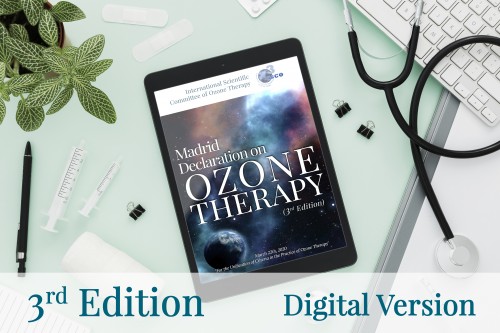Description /Descripción
The 3rd edition summarizes the scientific research carried out in different countries and are the result of many years of experience and clinical practice.
Ozone therapists from different parts of the world participated in the update of the 3rd edition. Through this exchange and subsequent revisions, the entire ozone therapy community had an opportunity to participate in a serious medical scientific exchange with the objective of having a global document to apply to patient care and improve clinical outcomes by health care professionals.
The Madrid Declaration on Ozone Therapy serve as a source of guidance and reference tor all those who practice ozone therapy. It is up to each ozone therapist to use his or her own clinical judgment in applying the recommendations included in the 3rd edition of the Madrid Declaration on Ozone Therapy.
1st edition: June 2010. | 2nd edition: June 2015. | 3rd edition: March 2020.
– INDEX –
Madrid Declaration on Ozone Therapy, ISCO3, 3rd ed., 2020
Available in ten languages: Arab, English, French, Italian, Portuguese, Russian, Spanish, Ukrainian, Mongolian & Turkish.
1. THERAPEUTIC BASIS
2. OZONE THERAPY (O3) BASIC PRINCIPLES
2.1 Contraindications
2.2 Warning
2.3 Interactions with Ozone
2.4 Adverse Effects
2.4.1 Grade 1 Mild
2.4.2 Grade 2 Moderate
2.4.3 Grade 3 Severe
2.4.4 Grade 4 2.4.5 Grade 5
2.5 Toxicity
2.6 Pediatrics Dosages through Rectal Insufflation
3. MAIN ROUTES OF APPLICATION
3.1 Recommended Systemic Routes of Application
3.1.1 Major Autohemotherapy (MAH)
3.1.2 Minor Autohemotherapy (MiAH)
3.1.3 Ozonized Saline Solution (O3SS)
3.1.4 Extracorporeal Blood Oxygenation-Ozonation (EBOO)
3.1.5 Rectal Insufflation
3.1.6 Vaginal Insufflation
3.2 Recommended Routes of Application with Local Effect
3.2.1 Intramuscular, Paravertebral and Intra-Articular Injection
3.2.2 Paravertebral Intramuscular Injection
3.2.3 Hernias
3.2.4 Intradiscal Treatment
3.2.5 Sacral Hiatus/Transluminal Peridural Infiltration
3.2.6 Intraforaminal Infiltration
3.2.7 Intra-articular Treatment
3.2.8 The Gloves Technique (Emphysema subcutaneous technique)
3.2.9 Gasification in Plastic Bag
3.2.10 Subcutaneous (Mesotherapy) Application
3.2.11 Ozone Suction Cup
3.2.12 Insufflation in Fistulas
3.2.13 Ophthalmologic
3.2.14 Insufflation Vesico-Urethral
3.2.15 Intra Prostatic
3.2.16 Otic Route
3.2.17 Intratonsillar Infiltration Route
3.2.18 Ozone Micro Doses in Trigger and Acupuncture Points
3.2.19 Topical Application of Water, Oil and Ozonized Creams
3.2.20 Sauna Cabin or Quasi-Total-Body Exposure to Ozone
3.3 Application Routes not Recommended for not Being Safe
3.3.1 Direct Intravenous Injection of Ozone (DIV)
3.3.2 Intra-Arterial Injection
3.4 Application Route Prohibited
3.5 Application Routes that Have not Received Total Consensus
3.5.1 Injection of Ozonized Water
3.5.2 Injection of Ozonized Glucose Solution
3.5.4 Intraperitoneal Ozone
4. PATHOLOGIES MORE APPROPRIATE TO BE TREATED WITH OZONE THERAPY
4.1 Diseases in the Level A
4.2 Diseases in the Level B
4.3 Diseases in the Level C
5. GENERAL BASIS FOR TREATMENT
5.1 Essential Requirements
5.2 Basic Rules to Perform Training in Ozone Therapy
References
ADDENDUM A. Applications of Ozone in Dentistry
ADDENDUM B. Applications of Ozone in Veterinary Medicine
Español:
Índice
RANGOS TERAPÉUTICOS PARA EL USO DEL OZONO
1. BASES TERAPÉUTICAS
2. OZONOTERAPIA (O3x) PRINCIPIOS BÁSICOS
Contraindicaciones
2.2 Advertencia
2.3 Interacciones con Ozono
2.4 Efectos Adversos
2.4.1 Grado 1 Medio
2.4.2 Grado 2 Moderado
2.4.3 Grado 3 Severo
2.4.4 Grado 4
2.4.5 Grado 5
2.5 Toxicidad
2.6 Dosificaciones en Pediatría a través de la Insuflación Rectal
3. PRINCIPALES RUTAS DE APLICACIÓN
3.1 Vías Sistémicas de Aplicación Recomendadas
3.1.1 Autohemoterapia Mayor (MAH)
3.1.2 Autohemoterapia Menor (MiAH)
3.1.3 Solución Salina Ozonizada (O3SS)
3.1.4 Oxigenación-Ozonización Extracorpórea de la Sangre (EBOO)
3.1.5 Insuflación Rectal
3.1.6 Insuflación Vaginal
3.2 Rutas de Aplicación Recomendadas con Efecto Local
3.2.1 Inyección Intramuscular, Paravertebral e Intraarticular
3.2.2 Inyección Intramuscular Paravertebral
3.2.3 Hernias
3.2.4 Tratamiento Intradiscal
3.2.5 Infiltración Sacro Hiato/Transluminal Peridural
3.2.6 Infiltración Intraforaminal
3.2.7 Tratamiento Intraarticular
3.2.8 Técnica del Guante (Técnica Subcutánea)
3.2.9 Gasificación en Bolsa de Plástico
3.2.10 Aplicación Subcutánea (Mesoterapia)
3.2.11 Ozono en Ventosas
3.2.12 Insuflación en Fístulas
3.2.13 Oftalmología
3.2.14 Insuflación Vesicouretral
3.2.15 Intraprostática
3.2.16 Ruta Ótica
3.2.17 Infiltración Intratonsilar
3.2.18 Microdosis de Ozono en Puntos Gatillo y de Acupuntura
3.2.19 Aplicación Tópica de Agua, Aceite y Cremas Ozonizadas
3.2.20 Exposición Cuasi Total del Cuerpo en Saunas de Ozono
3.3 Vías de Aplicación No Recomendadas por no Ser Seguras
3.3.1 Inyección Intravenosa Directa de Ozono (DIV)
3.3.2 Inyección Intraarterial
3.4 Ruta de Administración PROHIBIDA
3.5 Rutas de Aplicación que No Han Recibido Total Consenso
3.5.1 Inyección de Agua Ozonizada
3-5.2 Inyección de Solución de Glucosa Ozonizada
3.5.3 Método Multipasos Hiperbárico (HBO3)
3.5.4 Ozono Intraperitoneal
- PATOLOGÍAS MÁS APROPIADAS PARA SER TRATADAS CON OZONOTERAPIA
4.1. Enfermedades en el nivel A
4.2. Enfermedades en el Nivel B
4.3 Enfermedades en el Nivel C
5. BASES GENERALES PARA EL TRATAMIENTO
5.1 Requisitos Esenciales
5.2. Reglas Básicas para la Realizar la Formación en Ozonoterapia
Referencias
ADENDA A. APLICACIONES DEL OZONO EN ODONTOLOGÍA
ADENDA B. APLICACIONES DEL OZONO EN VETERINARIA MÉDICA
We DO NOT SEND this file though e-mail. Buying the access, you will be able TO ACCESS for online reading. It is NOT available for downloading or printing. Please, remember this before buying. ACCESS INSTRUCTIONS CLICKING HERE.
Ésta publicación NO SE ENVÍA POR E-MAIL. Comprando este ACCESO, usted podrá CONSULTARLA ONLINE. NO está disponible para descargar o imprimir. Por favor, tenga en cuenta estas características antes de comprar. INSTRUCCIONES DE ACCESO, CLICK AQUÍ.
![]()




Reseñas
No hay reseñas todavía.